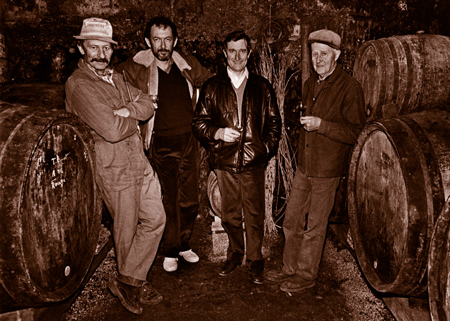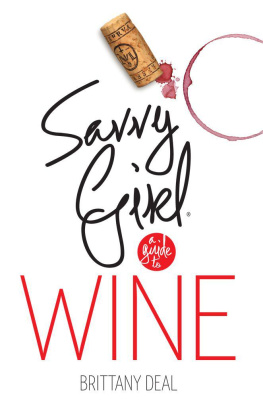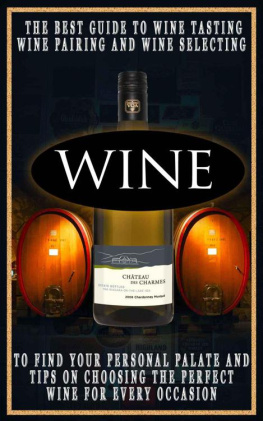
R. TROLLAT, K. LYNCH, G. CHAVE, E. TROLLAT

The author and publisher have provided this e-book to you for your personal use only. You may not make this e-book publicly available in any way. Copyright infringement is against the law. If you believe the copy of this e-book you are reading infringes on the authors copyright, please notify the publisher at: us.macmillanusa.com/piracy.
To my clients,
who make these adventures possible
CONTENTS
PREFACE TO THE 1988 EDITION
KERMIT LYNCH, when we first met some twelve years ago, described himself to me as a recently defected hippie. I had been in France since 1951, had never met a hippie, and was not very clear about the definition of the species; I soon came to realize that Kermit was merely an old-fashioned bohemian who happened to possess a remarkable nose and palate.
Today, Kermit rattles off French with impressive facility, while taking voluminous notes on each barrel or vat of wine as he swirls, sniffs, sucks, chews, and spits, but at that time his French was on the primitive side and, to ease the problems of communication, he had asked me to accompany him on a weeks ferreting out of vineyards in the Ctes du Rhne and Burgundy.
Before we headed for Chteauneuf-du-Pape, the southernmost stop on the Ctes du Rhne itinerary, a visit to the Peyrauds at Domaine Tempier (Bandol) was inevitable. The instant spark of sympathy kindled between Kermit and the ebullient family of Peyrauds could be likened to spontaneous combustion. Today, Kermit spends half the year in his recently acquired house in the back hills of Le Beausset, where part of the Bandol appellation is also cradled. He has been absorbed into the Peyraud family, and to Lucien Peyraud he is mon fils .
Among the other vignerons encountered on that trip, who are now cornerstones of Kermits stable, were Grard Chave in Hermitage, Auguste Clape in Cornas, Jean-Marie Ponsot in Morey-Saint-Denis Still others, whose wines were beautiful then, have since faltered in their loyalty to commonsense methods of vinification; these have fallen by the wayside to be replaced by the constantly unfolding new discoveries, often vignerons whose wines were sold to ngociants in the past, who have discovered that it is both more interesting and more profitable to raise and bottle their own wines.
This was not Kermits first wine-tasting trip to France, but I think that it may have been the real beginning of his Adventures on the Wine Route . If it was my pleasure to be able to open a few doors on that trip, it has been Kermits to open a great many more for me in the years that followed. I have, perhaps, been especially grateful for the discovery of certain wines from the less hallowed viticultural regionsinexpensive, clean, refreshing, and undemanding, ideal daily aperitif and summer luncheon wines; typical are Jean Berails white, Roque Sestire, and Yves Laboucaries vin gris , Domaine de Fonsainte, both from the southwest Corbires appellation .
Adventures on the Wine Route is an intensely personal book, permeated with an aura of intimacy between the author and the living, changing wines of which he writes, enhanced by the kind of knowledge born of experience. It is also generously truffled with opinions, tastes, beliefs, and attitudes, expressed with an impertinence which will delight most readers but which may trouble or outrage some members of the society that, in one of his brochures, Kermit has baptized the FWDP (Fine Wine-Drinking Public). His disdain for the contagious fad of blind and comparative tastings of unrelated wines will surely rub some furs the wrong way, as will his indifference to the New-Oak-Cabernet-Sauvignon global boom. Tant mieux
Like father, like son. Kermits father was a preacher and so is Kermit, but the sermons that Kermit delivers to his flock deal with things more worldly than brimstone fire; often invoked are the emasculating crime of filtering wines and the dangerous pitfalls open to the vintage-chart mentality.
Coupled with this amassment of information, messages, insights, and convictions is a gallery of portraits, some only sketches, others fully brushed in, of the people who make the wines, their dedication, their passions, their beliefs, their strengths and their weaknesses.
No book on wine and the people who make it has ever been written that remotely resembles Adventures on the Wine Route .
Sollis-Toucas, March 30, 1988
RICHARD OLNEY
INTRODUCTION
WE AMERICANS with our New World innocence and democratic sensibilities tend to think that all wines are created equal and that differences in quality are simply a matter of individual taste.
The French, with their aristocratic heritage, their experience and tradition, approach wine from another point of view. Just as France had its kings, noblemen, and commoners, French wine has its grands crus , premiers crus , and there is even an official niche for the commoners, the vins de table .
The wines produced by each nation are different, and the wine of each is well served by the two national viewpoints. One understands the style of California wines better when one understands the pioneer spirit, and one cannot appreciate French wine with any depth of understanding without knowing how the French themselves look at their wines, by going to the source, descending into their cold, humid cellars, tasting with them, and listening to the language they employ to describe their wines. It is not the vocabulary Californians employ, and often a precise translation of wine terms from one language to the other is impossible. I spend a third of the year tasting with the French winegrowers, and my book is about my experiences on the wine routes and in the wine cellars of France.
* * *
Some people think wine is a glamorous business. Witness the influx of big money into Californias Napa Valley. It is not merely a decent glass of wine that motivates investors, nor do they want to see their manicured fingernails stained purple. It is the dream of a certain lifestyle that lures them. I have even noticed people respond with an enthusiastic glimmer of envy when they learn of my profession, wine buyer and importer. Once I enjoyed a confrontation with a platinum-blond wine groupie who told me how exciting my buying trips must be, traveling through France, the fancy restaurants, the posh hotels, the little old winemakers. The fine black fabric of her blouse might have been diaphanous, but a look long enough to say for sure would have been prying. If you need someone to carry your suitcases, or whatever, let me know, she said. I would love to go with you next time. A day or two of it might be glamorous, but I wonder what she would have thought after a few days on the road.
When I opened a wineshop in 1972, I envisioned some tastes of glamour myself. I did not start by importing my own selections. I sold domestic and imported wines purchased from distributors, but I had dreams of going to the source. The first time I did buy wine directly from a winery, I went to an Italian grower near Martinez, California. After I had made a couple of visits to taste and buy his Zinfandel, he telephoned and invited me to lunch. Now Im getting to the heart of things, I thought, real winery cooking and some old treasures from his private cellar. And he did have a way with a tuna sandwich. He poured himself half a glass of red from an unlabeled bottle. I supposed he wanted me to guess the vintage. He passed the bottle to me, then grabbed a pitcher and filled his wineglass the rest of the way to the top with a murky-looking liquid. He offered the pitcher to me.













